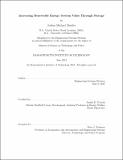Increasing renewable energy system value through storage
Author(s)
Mueller, Joshua M. (Joshua Michael), 1982-
DownloadFull printable version (25.59Mb)
Other Contributors
Massachusetts Institute of Technology. Technology and Policy Program.
Advisor
Jessika E. Trancik.
Terms of use
Metadata
Show full item recordAbstract
Intermittent renewable energy sources do not always provide power at times of greatest electricity demand or highest prices. To do so reliably, energy storage is likely required. However, no single energy storage technology is dominant when comparing cost intensities of the energy capacity and power capacity of storage. Past research on energy storage technologies has debated the value of storage technologies for different applications, and has compared the cost structures of different storage technologies without finding generalizable results across both locations and technologies. Here, a single performance metric, the benefit / cost ratio (X) of storage value added is analyzed across six locations globally to show that the relative value of storage technologies is largely location invariant. Electricity price dynamics, specifically the frequency and height of price spikes determine the value of storage, while the duration of price spikes determines the relative value of one technology versus another. We find that cost targets can be set for different technologies with ranging energy and power costs of storage.
Description
Thesis: S.M. in Technology and Policy, Massachusetts Institute of Technology, Engineering Systems Division, Technology and Policy Program, 2015. This electronic version was submitted by the student author. The certified thesis is available in the Institute Archives and Special Collections. Cataloged from student-submitted PDF version of thesis. Includes bibliographical references (pages 135-143).
Date issued
2015Department
Massachusetts Institute of Technology. Engineering Systems Division; Technology and Policy ProgramPublisher
Massachusetts Institute of Technology
Keywords
Engineering Systems Division., Technology and Policy Program.